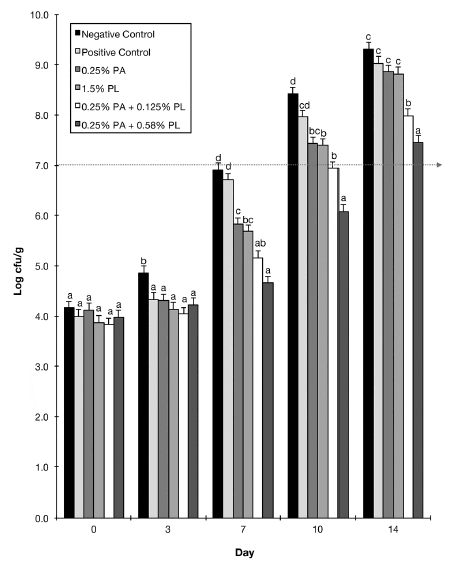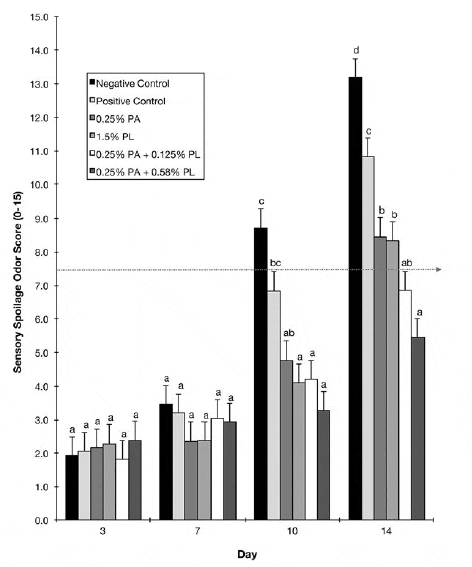It is important for catfish processors to be aware that the use of good manufacturing practices (GMP) and hazard analysis of critical control point (HACCP) is crucial in the production, storage, distribution, and retailing of fresh catfish products for safety and shelflife extension. In addition, antimicrobials can be applied or incorporated into fresh catfish products to prolong shelf life without diminishing quality.
The safety and shelf life of other meat products have previously been enhanced by preventing microbial growth and lipid oxidation through the use of antimicrobials and antioxidants. Among the potential chemical antimicrobials, certain organic acid salts, especially sodium lactate (SL) and sodium diacetate (SD) have received considerable attention (Shelef and Addala 1994; Shelef 1994).
This report highlights recent research findings from studies conducted at Mississippi State University that investigated the antimicrobial effects of potassium acetate (PA) and potassium lactate (PL) on fresh vacuum-tumbled catfish fillets. After a L. monocytogenes outbreak involving meat products in 1998–99, the USDA-FSIS announced increases in the permissible levels in meat products for sodium lactate, sodium acetate, and sodium diacetate to 3 per cent , 0.25 per cent , and 0.25 per cent of the finished product weight, respectively (USDA-FSIS 2000).
Catfish processors should also consider the following information when using antimicrobials: (1) use of a combination of antimicrobials coupled with refrigeration temperatures is highly suggested; (2) surface antimicrobial applications require higher amounts of antimicrobials to get the desired effect when compared with the addition of antimicrobials in the formulation of the products; and (3) treatments involving sodium diacetate could exert a bactericidal effect, whereas sodium lactate commonly exhibits a bacteriostatic effect (Drosinos and others 2009).
PL and PA are widely available, economical, and generally recognized as safe (GRAS). These antimicrobials are commonly used in meat and poultry products to extend shelf life and increase food safety as they have a broad antimicrobial action and are effective at inhibiting the growth of most spoilage and pathogenic bacteria. Potassium lactate (PL), a salt of lactic acid, is a chemical compound with the formula KC3H5O3 (H3C-CHOH-COOK) and potassium acetate (PA), a salt of acetic acid, is a chemical compound with the formula CH3CO2K (CH3-COOK).
The antimicrobial effect of sodium lactate may be due to decreased water activity (Chirife and Fontan 1980) and the increased permeability of cellular membranes for the lactate ion at a high pH (De Witt and Rombouts 1990). However, Carpenter and Broadbent (2009) stated that the inhibitory effects of weak acids cannot be fully attributed to their pH alone. These researchers reported that organic acids and organic acid salts can also exert effects on membrane function. The high levels of weak acid anions that accumulate in the cytoplasm can have osmotic effects on the cell and on metabolic processes that occur within the cytoplasm. In addition, sodium acetate has a stronger antibacterial activity but a weaker antioxidant activity than sodium lactate.
Highlights of Research at Mississippi State
Catfish fillets were provided by a local catfish processor. For each treatment, 5 kg of fillets were placed in a vacuum meat tumbler and then marinated with a brine solution formulated for a 10 per cent pick-up over green weight. The finished marinated product contained approximately 0.45 per cent phosphates and 0.5 per cent salt and variable percentages of PL and PA in the different product treatments (Table 1). The fillets were vacuum-tumbled (2–4°C, 20 mm Hg, 5 minutes, 20 rpm). The marinated fillets were placed on polyethylene trays, overwrapped with stretch film, and stored at 2–4°C throughout the shelf life of the product. The following attributes were evaluated to determine yields, color, pH, tenderness, consumer acceptability, and shelf life of fresh marinated catfish fillets.
Table 1. Percentage of Salt, Phosphate, Potassium Acetate, and Potassium Lactate Variables in the Finished Treatments

2Ultra-Pure PA, Hawkins, Minneapolis, Minnesota.
3Ultra-Pure PL-85, Hawkins, Minneapolis, Minnesota.
4Ultra Pure Bestate-P, Hawkins, Minneapolis, Minnesota.
5Ultra Pure Bestate-P4218, Hawkins, Minneapolis, Minnesota.
Research Findings at MSU
No differences existed among the treated and untreated fillets with regards to solution pick-up and pH (Table 2). This indicates that the addition of PA and/or PL did not affect pH and the ability of the catfish fillets to pick up marinade in a vacuum tumbling system. All treated fillets increased yields based on green weight (Table 2). Treatments did not affect the color (redness and yellowness) of the marinated catfish fillets. In addition, all treated catfish fillets were more tender (total energy) than untreated catfish fillets (Table 2). This indicates that PA and PL did not affect the tenderness of catfish fillets, but the increased tenderness may have been due to the presence of agglomerated sodium phosphate blend (AGSP) in the marinade.
The shelf life of catfish fillets treated with a combination of PA and PL was extended to 10–14 days, while the shelf life of catfish fillets from other treatments was limited to 7–10 days (Figure 1). Silva and others (1993) and Silva and White (1994) reported that spoilage occurs at 8 log cfu/g when lactic acid bacteria (LAB) are the predominant microflora in a seafood product. Therefore, catfish fillets in the current study may not have been spoiled when psychrotrophic plate counts (PPC) reached 7 log cfu/g because LAB counts were found to increase from 3 log cfu/g at 0 days of storage to 6 log cfu/g after 14 days of storage.
This explains why samples that were treated with a combination of PA and PL did not appear spoiled based on sensory spoilage odor scores (Figure 2). In addition, consumers preferred catfish fillets that were marinated with salt and phosphate, with or without antimicrobial treatment, over the untreated (negative control) with respect to appearance, flavor, and overall acceptability (Table 3).
Table 2. Yields and Quality Attributes of Vacuum-tumbled Catfish Fillets Enhanced with Variable Percentages of Potassium Acetate and Potassium Lactate.1

2Negative control = no phosphate and salt; positive control = 0.45 per cent phosphate and 0.5 per cent salt; 0.25 per cent PA = 0.25 per cent potassium acetate plus phosphate and salt; 1.5 per cent PL = 1.5 per cent potassium lactate plus phosphate and salt; 0.25 per cent PA + 0.125 per cent PL = 0.25 per cent potassium acetate and 0.125 per cent potassium lactate plus phosphate and salt; and 0.25 per cent PA + 0.58 per cent PL = 0.25 per cent potassium acetate and 0.58 per cent potassium lactate plus phosphate and salt.
3Green weight is the weight of raw catfish fillets prior to marination.
4Shear force (N/g) = Maximum peak force required to shear through the sample.
5Total energy (J/g) = Area under the curve required to shear through the sample.
6NA = Not applicable because the control treatment was not marinated.
Table 3. Mean Scores for Overall Consumer Acceptability (N=180) of Vacuum-tumbled Catfish Fillets Enhanced with an Agglomerated Blend of Sodium Phosphates and Variable Percentages of Potassium Acetate and Potassium Lactate.1

2Negative control = no phosphate and salt; positive control = 0.45 per cent phosphate and 0.5 per cent salt; 0.25 per cent PA + 0.125 per cent PL = 0.25 per cent potassium acetate and 0.125 per cent potassium lactate plus phosphate and salt; and 0.25 per cent PA + 0.58 per cent PL = 0.25 per cent potassium acetate and 0.58 per cent potassium lactate plus phosphate and salt.


Summary and Conclusions
- Catfish fillets that were marinated with salt, an agglomerated phosphate blend (AGSP), and a combination of commercially available PA and PL inhibited the growth of psychrotrophic bacteria on refrigerated (2–4°C) catfish fillets with PA and PL combinations maximizing antimicrobial effects.
- The use of AGSP combined with PA and PL extends the microbiological and sensory shelf life of refrigerated catfish fillets as well as enhances the sensory acceptability of fried catfish fillets when compared with nonmarinated catfish fillets. In addition, no difference in acceptability occurred between marinated fillets that were treated with antimicrobials and those that were not.
May 2013




